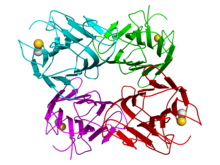Concanavalin
| Concanavalin A | |
|---|---|

|
|
| Identifiers | |
| Organism | |
| Symbol | ConA |
| PDB | 3CNA More structures |
| UniProt | P81461 |
Concanavalin A (ConA) is a lectin (carbohydrate-binding protein) originally extracted from the jack-bean, Canavalia ensiformis. It is a member of the legume lectin family. It binds specifically to certain structures found in various sugars, glycoproteins, and glycolipids, mainly internal and nonreducing terminal α-D-mannosyl and α-D-glucosyl groups. ConA is a plant mitogen, and is known for its ability to stimulate mouse T-cell subsets giving rise to four functionally distinct T cell populations, including precursors to suppressor T-cell; one subset of human suppressor T-cells as well is sensitive to ConA. ConA was the first lectin to be available on a commercial basis, and is widely used in biology and biochemistry to characterize glycoproteins and other sugar-containing entities on the surface of various cells. It is also used to purify glycosylated macromolecules in lectin affinity chromatography, as well as to study immune regulation by various immune cells.
Like most lectins, ConA is a homotetramer: each sub-unit (26.5KDa, 235 amino-acids, heavily glycated) binds a metallic atom (usually Mn2+ and a Ca2+). It has the D2 symmetry. Its tertiary structure has been elucidated, and the molecular basis of its interactions with metals as well as its affinity for the sugars mannose and glucose are well known.
ConA binds specifically α-D-mannosyl and α-D-glucosyl residues (two hexoses differing only by the alcohol on carbon 2) in terminal position of ramified structures from B-Glycans (reach in α-mannose, or hybrid and bi-antennary glycanes complexes). It has 4 binding sites, corresponding to the 4 sub-units. The molecular weight is 104-112KDa and the isoelectric point (pI) is in the range of 4.5-5.5.
...
Wikipedia
